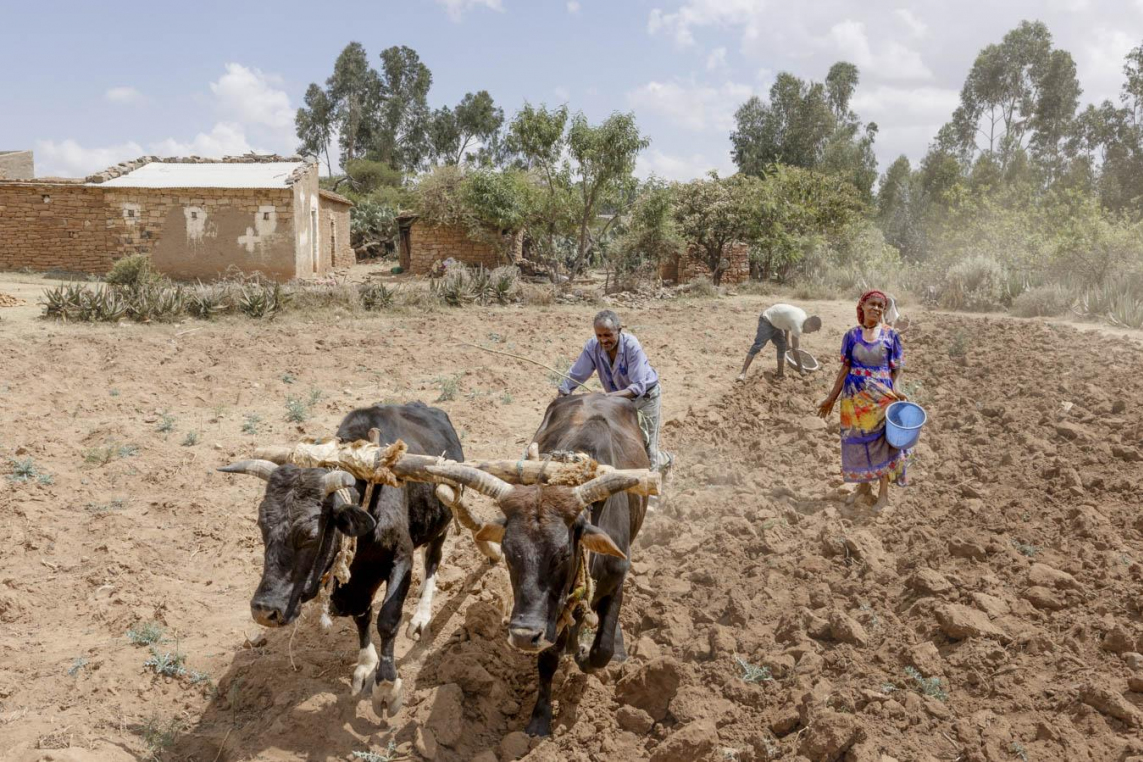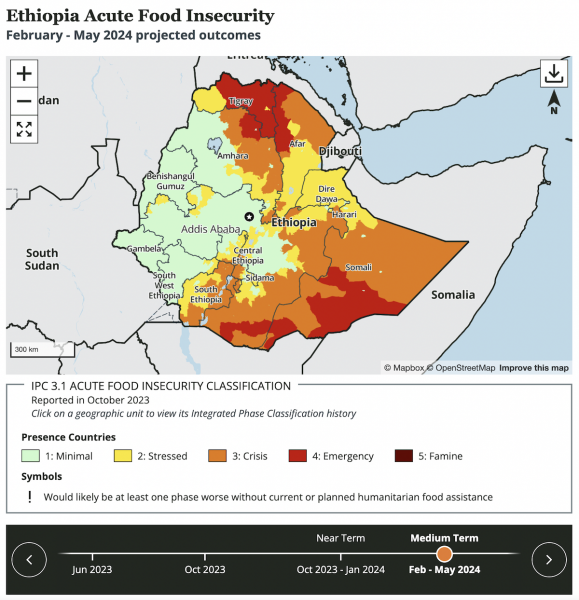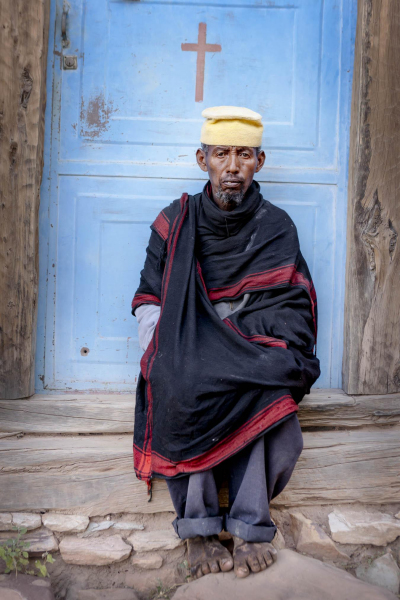Tom Claes is eindredacteur en journalist. Hij volgt de ontwikkelingen in de Hoorn van Afrika en focust in het bijzonder op de thema’s identiteit, conflict en ongelijkheid.
‘The land is dead’: once again, millions of Ethiopians are on the brink of famine

In November and December 2023, 816 people are already reported to have died of hunger, according to the Tigrayan authorities.
© Pauline Niks
It hardly seems like news: a new famine is looming in Ethiopia. For some Ethiopians, it would be the fourth in their lifetimes. And more than drought, political factors such as the recent war in Tigray are at play. ‘What can I do? I am too old, I have nowhere to go.’
T
he rains came early this year in Tigray, in the north of Ethiopia. The clouds came and went, and finally stayed away.
Tesfay* (71) crouches on the ground and looks worriedly up at the blue sky. He sniffs the warm air and begins to dig into the loose earth. He has been a farmer all his life. His neck and back hurt, but he has no choice but to continue working in the fields. “I have seven mouths to feed,” he says. “Everyone is hungry.”
In the bright afternoon light, his field looks like an endlessly scorched surface. As he digs into it with his stick, a glowing cloud of dust rises. Patiently, he picks the last grains of wheat from the ground.
“Normally I harvest about 200 kilograms of wheat from this field,” says Tesfay. “This year, the best I can hope for is 40 kilos. That will only last my family two months. I have no choice but to sell some of my livestock, otherwise we will starve.”

The international food monitoring system, IPC, expects much of Tigray to be in level 4 by the first half of 2024.
© Famine Early Warning System
Tesfay was born near Wukro, a town in eastern Tigray. The entire Ethiopian state is almost twice the size of Belgium. It is home to some 5.7 million people, about 80 per cent of whom depend on agriculture for their livelihoods.
For two years, Tigray was the scene of an unusually violent war that killed hundreds of thousands of people. The Ethiopian army fought side by side with troops from Eritrea and the Amhara region against the Tigrayan forces, the Tigray Defence Forces (TDF).
A peace agreement ended hostilities on 2 November 2022. But now the effects of the war and the ongoing drought threaten 4.5 million Tigrayans with famine, according to Tigrayan agencies.
The international food monitoring system, IPC, expects much of Tigray to be in phase 4 by the first half of 2024. This is the second most severe level of food insecurity, after famine (phase 5). In phase 4, there is acute malnutrition and excess mortality, and people have to resort to emergency strategies to cope with food shortages.
In November and December 2023, 816 people are already reported to have died of hunger, according to the Tigrayan authorities. At least 141,000 hectares of farmland in southern and eastern Tigray have been affected by severe drought. This has threatened the vital November-December harvest.

In November and December 2023, 816 people are already reported to have died of hunger, according to the Tigrayan authorities.
© Pauline Niks
Rural economy
Agriculture in Tigray, as in many places around the world, has always depended on rain. Even in Tesfay’s childhood, droughts could be devastating. When the rainy season failed, crops such as barley, wheat or teff would not grow and the fields would remain empty.
The region has also become more densely populated over the years. Trees were cut down en masse to make way for new farmland. This depleted the soil and water resources. The land was exhausted and crops failed.
Apart from the hunger during the last war, Tesfay experienced at least three famines in his lifetime. The first, in 1958, killed more than 100,000 Tigrayans. A second in the 1970s, when Emperor Haile Selassie feasted while everyone crawled outside the palace walls. And finally, the biggest of all: the 1984-85 famine. At least 400,000 Ethiopians (the United Nations puts the figure at more than double that) died of starvation, about half of them in Tigray.“We lost everything in the war, even the land is dead.”
Each time, the drought was only part of the story. In the famines of 2021 and 2022, it was not part of it at all. The mass deaths were just as much man-made.
In the 1980s, the troops of Marxist dictator Mengistu Haile Mariam deliberately bombed schools, markets and fields to crush rebel groups such as the Tigrayan People’s Liberation Front (TPLF). Huge amounts of farmers were brutally relocated to new villages in other parts of the country, ostensibly to combat overpopulation — with all the consequences and conflicts that entails.
In 1991, a coalition led by the TPLF overthrew Mengistu’s rule and then took over the government. Unlike their predecessors, the new rulers understood how the rural economy worked. They protected farming communities from shifta (bandits) and distributed land to the population.
They also tried to combat soil erosion with reforestation projects and all sorts of water harvesting schemes. With success. Or that was the case at least in Tigray, because other parts of the country were less well looked after. In those regions, famine would flare up again and again.
For years, Tesfay also used a communal well to water his vegetable garden. Today, the well is a sandy pit in a barren landscape. “My plants are completely dead,” he sighs.
But the lack of water is not the only problem. “This year I have only been able to get 25 kilograms of fertiliser. That’s less than half of what I used to get. What can I do with it? We lost everything in the war, even the land is dead.”
“Even the cattle were looted”
Tesfay was working in his field in the spring of 2021 when Eritrean soldiers arrived in his village. “I was lucky to be able to continue ploughing during the war, so we still had food,” he says. When the soldiers entered my house, they searched everything. But they took nothing except some wood.
“Other farmers in the area were less fortunate,” he continues. “They had to give up part of their crops and tools. Those who refused usually paid with their lives.”
An official at the Ministry of Agriculture in Tigray, who prefers to remain anonymous, says that fields, farms and health facilities were looted or destroyed en masse during the war. And there is no money to repair it all.
“Before the war, our department received a generous budget from the federal government. It was enough to support agriculture in Tigray. This year, we received about half that amount. So we have stopped most of our activities out of necessity, often because the infrastructure is no longer there.”
He gives an example: “Almost every community in Tigray had a training centre where experts like me trained farmers. The centres were fully equipped and had agricultural plots to test new or improved technologies.”
“A quarter of the centres had animals, so they could also experiment with animal husbandry. Many of these buildings were razed to the ground. Even the animals were looted or killed.”

Farmers close to Wukro.
© Pauline Niks

Farmers near Wukro (Tigray).
© Pauline Niks

“Before the war, our department received a generous budget from the federal government. It was enough to support agriculture in Tigray.”
© Pauline Niks
Has the peace agreement made things better? “It has silenced the guns in large parts of Tigray,” the official nods. But it has not been fully implemented. According to the agreement, there should be a constitutional solution for Western Tigray. The disputed area is officially part of Tigray, but is also claimed by the Amhara.
Ethiopian Prime Minister Abiy Ahmed allowed Amhara militias to annex the area in exchange for their support in the war. The peace agreement stipulated that these militias should leave the area, but this has not happened. In parts of western and southern Tigray, they have still not left, preventing people from returning to their homes.
“What can I do? I am too old, I have nowhere to go.”
“If we lost this region for good, it would have a huge impact,” says the official. “Not only because it is a very fertile agricultural area with huge economic potential. But also because it is a region from which many people have fled.”
“More than a million people in Tigray still live in IDP (internally displaced person) camps where there is a severe lack of basic services such as food, clean water and health care. But no one seems to care.”
Following the peace agreement, humanitarian aid from UN agencies and Western governments gradually began to arrive. But after aid workers discovered that food aid was being diverted by corrupt Ethiopian and Tigrayan officials, it was suspended for months. That decision led to the deaths of at least 1,400 people between April and August last year, a government source told the BBC in August.
Aid has since resumed, but it has been too slow and too little. The transitional government in Tigray says it is only enough to meet 20% of the needs.
“I have received nothing in three years of aid,” says Tesfay. He looks at his field, shrugs his shoulders and mumbles: “What can I do? I am too old, I have nowhere to go.”

Farmer close to Wukro (Tigray)
© Pauline Niks

Farmers near Wukro (Tigray).
© Pauline Niks
Where should the money go?
The Ethiopian government says it needs 20 billion dollar to rebuild Tigray. But the economy is in tatters, hit by the coronavirus pandemic and two years of civil war. Long hailed as an African tiger, Ethiopia is struggling to pay its debts. Inflation is hovering around 30 per cent and food and fuel prices are soaring.
“Before the war, I used to pay 25 to 30 birr (about 0.50 dollar) for a litre of petrol,” says a rickshaw driver in Mekelle, the capital of Tigray. Now it is 75 birr (1.30 dollar) at the pump and 100 birr (1.70 dollar) on the black market when petrol stations run out. The price hike means I can no longer put food on the table for my wife and children.
Birthday celebration and palace complex
In 1973, during a period of famine, Haile Selassie was accused of spending around 35 million dollar to celebrate his 80th birthday. In 1984, Mengistu Haile Mariam was said to have spent between 100 million and 200 million dollar to celebrate the 10th anniversary of his rule, while in much of the country people were fighting for every grain.
According to the Tigrayan transitional government, Tigray is on the brink of a humanitarian emergency reminiscent of the catastrophic famine of 1984-85. And Tigray is not alone. People in Somali, Oromia, Amhara and Afar are also facing food shortages. In total 20 million (out of 120 million) Ethiopians need humanitarian aid.
But while Ethiopians starve, Prime Minister Abiy Ahmed is planning a monumental palace complex with a waterfall and several luxury villas. The cost is secret for now, but according to Africa Confidential, figures over 15 billion dollar are circulating.

Fields near Saint Mary’s Church where the massacre happened.
© Pauline Niks

Maryam Dengelat church. Middle: the monk of the church.
© Pauline Niks
Escaping a bloodbath
Fifty kilometres north of Wukro, in the shadow of St Mary’s Church in Dengelat, Hagos* (30) is sitting on a stone wall. He has just gathered the last of the straw into big bales. His work is done for the day.
“The crops are not ripe,” he says. “This year we have only been able to buy 50 kilos of fertiliser, before the war we used to get three times as much. You can see the effect,” he says, pointing to his field. The yield is lower and the straw is thinner.
His family started out with five animals. Of those, only one animal remains, Hagos says: “Because of the drought, we sold almost everything. We had to survive. My father plans to buy another ox with the proceeds of our harvest, because you can’t plough with one animal. But we can hardly survive on our own. I expected the peace agreement to bring improvements, but so far we have not received any help.”
Since the age of 19, Hagos has made at least five attempts to flee to Saudi Arabia in search of a better life. Each time he was stopped somewhere along the way. He tried again during the recent war, but was caught again. He ended up in a prison in the neighbouring region of Afar. Little did he know that this would prove to be his salvation.

Monk of the Maryam Dengelat church.
© Pauline Niks
In late November 2020, while Hagos was in prison, dozens of pilgrims had gathered at St Mary’s Church to celebrate the Orthodox festival of Tsion Maryam. As the celebrants returned from a ceremony in the church, Eritrean soldiers opened fire. They had set up camp nearby and were looking for Tigrayan fighters.
“In a panic, people scrambled up the hill on rocky paths,” recalls the monk of St Mary’s Church. He witnessed the massacre at close. “People hid in the bush for days or tried to reach neighbouring villages. No one dared to come down for fear of being killed. We survived by eating the roots and stems of edible wild plants.”
“Others were less lucky and were captured by the soldiers. At least 56 people were massacred there,” says Hagos, pointing to an open field. It is unclear how many people died in total.
“Six of the victims were my wife’s relatives. My mother and sister were also rounded up. They were lucky, a soldier eventually let them go. My sister has now joined the Tigrayan army.”
Does he still dream of a life elsewhere? Of course he does. “But that dream has been put aside. There were eight of us at home. My sister and brothers went to fight with the Tigrayan forces; one of them was killed in the war. If the others ever return home, I can go back to work in trade. But for now I will stay here, there is no one else to help my parents.”
*Tesfay and Hagos are pseudonyms, their real names are known to the editors.
Maak MO* mee mogelijk.
Word proMO* net als 2798 andere lezers en maak MO* mee mogelijk. Zo blijven al onze verhalen gratis online beschikbaar voor iédereen.
Meer verhalen
-
Report
-
Report
-
Interview
-
Analysis
-
Report
-
Interview












 Oxfam België
Oxfam België Handicap International
Handicap International